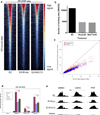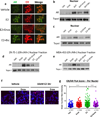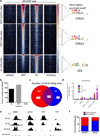Cooperative Dynamics of AR and ER Activity in Breast Cancer
- PMID: 27565181
- PMCID: PMC5107172
- DOI: 10.1158/1541-7786.MCR-16-0167
Cooperative Dynamics of AR and ER Activity in Breast Cancer
Abstract
Androgen receptor (AR) is expressed in 90% of estrogen receptor alpha-positive (ER+) breast tumors, but its role in tumor growth and progression remains controversial. Use of two anti-androgens that inhibit AR nuclear localization, enzalutamide and MJC13, revealed that AR is required for maximum ER genomic binding. Here, a novel global examination of AR chromatin binding found that estradiol induced AR binding at unique sites compared with dihydrotestosterone (DHT). Estradiol-induced AR-binding sites were enriched for estrogen response elements and had significant overlap with ER-binding sites. Furthermore, AR inhibition reduced baseline and estradiol-mediated proliferation in multiple ER+/AR+ breast cancer cell lines, and synergized with tamoxifen and fulvestrant. In vivo, enzalutamide significantly reduced viability of tamoxifen-resistant MCF7 xenograft tumors and an ER+/AR+ patient-derived model. Enzalutamide also reduced metastatic burden following cardiac injection. Finally, in a comparison of ER+/AR+ primary tumors versus patient-matched local recurrences or distant metastases, AR expression was often maintained even when ER was reduced or absent. These data provide preclinical evidence that anti-androgens that inhibit AR nuclear localization affect both AR and ER, and are effective in combination with current breast cancer therapies. In addition, single-agent efficacy may be possible in tumors resistant to traditional endocrine therapy, as clinical specimens of recurrent disease demonstrate AR expression in tumors with absent or refractory ER.
Implications: This study suggests that AR plays a previously unrecognized role in supporting E2-mediated ER activity in ER+/AR+ breast cancer cells, and that enzalutamide may be an effective therapeutic in ER+/AR+ breast cancers. Mol Cancer Res; 14(11); 1054-67. ©2016 AACR.
©2016 American Association for Cancer Research.
Conflict of interest statement
Vernon T. Phan is a fulltime employee of Medivation, Inc.
Figures







References
-
- Peters AA, Buchanan G, Ricciardelli C, Bianco-Miotto T, Centenera MM, Harris JM, et al. Androgen receptor inhibits estrogen receptor-alpha activity and is prognostic in breast cancer. Cancer research. 2009;69(15):6131–6140. - PubMed
-
- Vera-Badillo FE, Templeton AJ, de Gouveia P, Diaz-Padilla I, Bedard PL, Al-Mubarak M, et al. Androgen receptor expression and outcomes in early breast cancer: a systematic review and meta-analysis. Journal of the National Cancer Institute. 2014;106(1):djt319. - PubMed
-
- Tsang JY, Ni YB, Chan SK, Shao MM, Law BK, Tan PH, et al. Androgen receptor expression shows distinctive significance in ER positive and negative breast cancers. Annals of surgical oncology. 2014;21(7):2218–2228. - PubMed
-
- Panet-Raymond V, Gottlieb B, Beitel LK, Pinsky L, Trifiro MA. Interactions between androgen and estrogen receptors and the effects on their transactivational properties. Molecular and Cellular Endocrinology. 2000;167:139–150. - PubMed
MeSH terms
Substances
Grants and funding
LinkOut - more resources
Full Text Sources
Other Literature Sources
Medical
Research Materials

